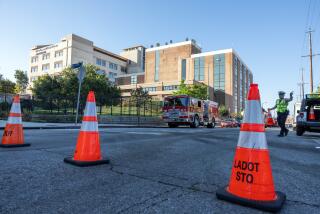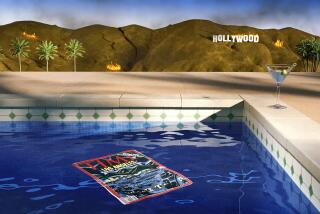Some disquiet on these L.A. film sets

The iron chain falls with a clang as the old man steps into the dark, deserted hallway of Linda Vista Community Hospital. Lights flicker and a stench of mold hangs in the air. Down the main corridor, a lone metal gurney rests against a wall.
More than a century ago, the six-story building in Boyle Heights opened to much fanfare as Santa Fe Coast Lines Hospital. The Mission-style building -- with verandas, a dome tower and sweeping views of downtown Los Angeles -- catered to railroad workers across the Southwest. Patients were cared for by a surgeon who once tended to Howard Hughes; they drank fresh milk from the hospital’s own Jersey cows.
They were brought into the lobby in wheelchairs, taken up an elevator operated by the simple pressing of a button and delivered to a heated room that could swiftly be evacuated by automatic fire escape.
“So complete and unique are the automatic features of the new hospital that it will not be strange if all who enter therein for treatment are healed automatically,”announced a 1904 newspaper article.
Now the wheelchairs are gone, the elevators broken. The heating-and-cooling system hasn’t worked for 16 years. Jesus Mena walks the halls alone -- flashlight in hand, keys clinking on his leg -- like an orderly making his final rounds. The 73-year-old watches over a building that in less than two decades went from community hub to haunted house.
Rumors of ghosts attract intruders almost nightly. They smash padlocks, break windows and knock down doors to slip in and rattle one another’s nerves.
People say they see things: A little girl cries for help from the fifth floor; a doctor roams from north to south inside a corridor; a green light radiates after dark from some of the windows.
But nothing is really as it seems inside Linda Vista: not the steely morgue at the end of the maze-like corridor, not the sound of humming in the room next door, not the tiny footprints running in a circle on the floor.
End of the line
It used to be the entrance was lush, lined with flowers and palm trees, and the hospital on the hill was a place for nursing people back to life, not for searching out the dead. Railroad workers with tuberculosis were cared for in furnished, heated tents on the hospital grounds. Conductors and engineers whose limbs had been crushed under moving boxcars recovered from amputations while enjoying picturesque views of Hollenbeck Park.
The worst cases were rushed to the burgundy-and-yellow-tiled trauma room. And those who died went to the hospital’s own morgue, underneath the dining hall on the first floor.
“It was really quite sophisticated,” said Ken Bernstein, manager of Los Angeles’ Office of Historic Resources.
“Here you had an integrated healthcare system providing for its employees well before most labor unions had won those types of health benefits.”
But in the 1970s, people began complaining that the 150-bed hospital was too exclusive, that it poorly served the area’s growing Latino population. In 1981, the railroad sold the hospital to a corporation.
Meanwhile, a drop in Medicare reimbursements began to hit the hospital hard. In 1989, the emergency room closed. In 1991, the hospital shut down altogether. The building’s value dropped from about $10 million to less than $4 million.
“Once that occurred, it just became an empty shell,” said Francis Kortekaas, who has managed the property for 22 years.
More than half a dozen owners have taken over Linda Vista since then. The investors come in with grand ideas: a new hospital, a charter school, a rehab center, a senior home or lofts.
But the obstacles to reviving the grand stucco building have defeated one dreamer after another.
When one owner suggested developing the land in 2002, a former tenant intervened, afraid the structure would be razed. She succeeded in getting the hospital placed on the city’s list of historic-cultural monuments. Later, it was added to the National Register of Historic Places.
The “historic” designation has trapped the property in a sort of purgatory, Kortekaas said, since developers don’t want to invest in a property with such a restriction. The site is also not earthquake-safe.
“They take notice a lot but just walk away,” he said.
The property remains for sale, but no one is rushing to make an offer.
Paging Hollywood
The Spanish tile roof, the caboose-inspired hallways, the Art Deco ceramic floors: Kortekaas didn’t want those charming details forgotten when Linda Vista shut down in 1991.
So he decided to call on Hollywood. The manager began to market the grounds as a film location. Soon, production managers from TV shows and movies big and small began to call: “Outbreak,” “End of Days,” the pilot season of “ER,” “Pearl Harbor.”
Crews turned neglected patient rooms and corridors into jail cells, chapels, classrooms and lofts, then insane asylums and interrogation rooms, then science labs and party scenes. They left behind props: cages, jars full of faux organs, church pews, phantom masks.
Not far from the real morgue, Kortekaas built a replica to attract more production.
He brought in gurneys, autopsy beds, incubators and other medical equipment similar to that auctioned off when Linda Vista closed. He and Mena sometimes stuck around until 1 or 2 a.m. to wait for crews to finish.
Film location rental fees paid electricity bills, property taxes, Kortekaas’ salary. But the money coming in was never enough to keep the place from crumbling, he said.
Heat, cold, rain, mold, rats, trespassers and time wore the building down. Soon it was the sinister air and bone-chilling corners, not the architecture, that lured location scouts, particularly those shooting horror movies. They splattered fake blood on the walls, scrawled messages with spray paint, chalk and felt-tip markers:
Jesus is Dead
I live in the walls
The end is near.
By 2005, it was not unusual for Mena to welcome vampires, zombies and witches into the old hospital, makeup artists in tow. He sat quietly in the distance with the building’s stray cat, Benjie, trying not to get in the way.
At the park across the street, it was hard to interpret all the signs from within the hospital.
Jorge Lopez, 20, and his friends grew up daring one another to one day cross St. Louis Street, slip across the gravel driveway and disappear into Linda Vista to explore.
They wanted to know if the stories people told were true.
“Who knows?” Lopez said as he sat on a park bench one morning, staring at the hospital’s windows. “But my cousin sneaked inside one time and she told me, ‘Stay away from it.’ So I did.”
An eerie feeling
No one can say what came first: the hauntings or the haunted sets. But it is those who are paid to make the place look creepy who are often the most creeped out.
Crew members who spend hours building sets not far from the asbestos-lined walls, soil-caked bathtubs and puddles of dirty water walk away with unexplained experiences. Some avoid certain hallways, certain rooms. Especially after dark.
“Everything is fine in most of the building, but there are places where the air suddenly changes,” said prop master Bonnie Temple, 38. “There’s a feeling that if I go any further, if I keep walking in that direction, something’s going to get me.”
Last year, Temple spent two months working long hours inside the hospital. Twice she saw what seemed like an orderly in a white short-sleeved shirt lurking by the windows. Twice, when a set dresser on her crew walked past that same area, he had to run outside and vomit.
“I will work there again if I have to, but I dread it,” Temple said.
In recent years, the hearsay has lured a new batch of visitors to Linda Vista: ghost hunters.
Paranormal groups and television shows from the East Coast, Canada and Japan have lined up to investigate.
They arrive after dusk at the surgery rooms, where they set up tape recorders, lasers, infrared cameras and ghost thermometers. Over the distant roar of Interstate 5, they call out to supposed spirits lurking in the darkness. They invite them to come out.
Earlier this year, a ghost-hunting group hosted a launch party, with cookies and mints, inside the hospital’s beamed dining hall. About 200 people showed up.
Most leave convinced that the building is haunted.
“It’s one of the scariest lockdowns we’ve had so far,” said Zak Bagans, host of “Ghost Adventures,” a Travel Channel show that hunts for phantoms inside prisons, mental wards and old hotels worldwide. After the program aired in December, Kortekaas was flooded with more requests.
And more attempts to break in.
He and Mena are left to board up broken doors and windows as the parade of bizarre trespassers continues to come through: the teenage girls who once slipped in to mutilate themselves as part of a blood ritual; the Satan worshiper who refused to leave and marked the main office with a 666, the sign of the devil; the group of boys who set the lobby on fire.
Mena once came upon a bunch of young prowlers.
“I said, ‘Eyy! What are you doing here?’ ”
The young men raced toward him in the dark corridor. They dived on top of him with fists and a stick, busted his head open and left him crying out for help.
As Mena steps into the sunshine on a recent morning, he tries to explain why things came to be this way at Linda Vista. He can’t. For him, the building will always be a peaceful place, a refuge of sorts.
After five wives and a lifetime of worries, he has this to keep him busy, he says.
But like so much at Linda Vista, it’s not what it seems.
Mena has no official title. He doesn’t get paid.
The retired security guard just shows up day after day on a bus from Norwalk.
He sweeps the floors, watches TV inside the old nurses quarters and builds things in the wood shop. He likes to sit near the front gate as Benjie slinks nearby.
When passersby stop to ask about the ghosts, the old man who in his own way haunts the building tells them:
“The only monsters around here are those hoodlums who won’t let this building rest.”
esmeralda.bermudez @latimes.com
More to Read
Start your day right
Sign up for Essential California for news, features and recommendations from the L.A. Times and beyond in your inbox six days a week.
You may occasionally receive promotional content from the Los Angeles Times.







